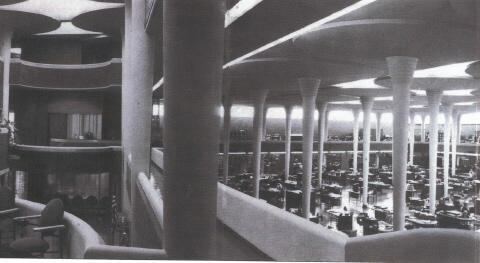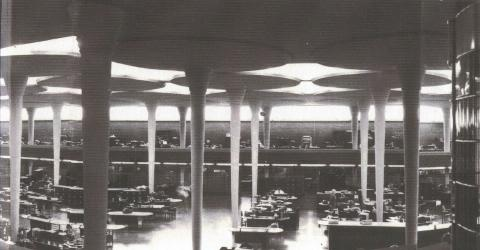
THE JOHNSON WAX BUILDING
In 1936 Frank Lloyd Wright was commissioned to design the Johnson Wax Administration Building. Interestingly, Herbert Johnson had already employed a different architect to design his building, and the drawings had been completed and construction was about to commence on the very non-descript design. But then two of Johnson's trusted executives persuaded him to talk to Frank Lloyd Wright, and subsequently Johnson hired Wright for the job. So Herbert Johnson threw out the drawings he had already paid to have done, and Mr. Wright started work. At first glance this seems an incredible move for a business man to have made, all that money wasted. But, instead, the building that Frank Lloyd Wright designed for the Johnson Wax Company brought so much fame and new business to the firm that this money was reimbursed many thousand times over.
"It is one of the most intriguing and significant aspects of Wright's long career that almost all of his public buildings were introspective and virtually windowless while his private works were extroverted and integrated with the landscape. Where the one, the urban monument, was predicated on an internal semipublic realm, illuminated from above, the other, the private house invariably extended its enclosure, through continuous fenestration, outriding terraces, and overhanging eaves, into the surrounding beneficence of nature," says Jonathan Lipman, in his definitive book "Frank Lloyd Wright and the Johnson Wax Buildings." Mr. Lipman goes on further to indicate that this design concept was more Romantic Emersonian in that Mr. Wright extolled the Edenic beauty of the landscape and hated the ugliness of the American City, where most of his public buildings were built.
Well, yes and no. The site for the Larkin Building in Buffalo was ugly, certainly, and so turning the building inward made sense; and, likewise, the site for the Johnson Was Building was not beautiful, and the structure was turned inward and the inside was lovely; as too, were the Guggenheim Museum and the church in Oak Park and the synagogue in Philadelphia. Contrarily though, the Unitarian Church in Madison was opened to the exterior views, and, since the site for the Marin County Civic Center was in the beautiful rolling hills of northern California, the buildings were opened outward, lined with windows.

I believe that Frank Lloyd Wright designed his buildings based upon the site: for a beautiful site he turned the building outward so that people could appreciate the views; for an ugly site, he turned the building inward, trying to make the interior so beautiful that one was not even aware there was an exterior.
And in the Johnson Wax Building Frank Lloyd Wright designed one of his great interiors. As Robert McCarter says in his fine book on Frank Lloyd Wright, "The columned 'great workroom' is one of Wright's most astonishing spaces, surrounded by the light bands in the brick enclosing walls and opened by a series of tubular glass skylights that fill in between the curved tops of the column petals (columns); as Wright said, 'the effect is that of being among the pine trees, breathing fresh air and sunlight'. The toplight, and the refractions of the curved glass tubing in general, impart a certain sense of distance, so that we feel we are in a world apart from the everyday."

It is a wonderful great room to work in! Over the many years since its construction, Mr. Wright's great spaces and building have resulted in increased productivity and pleasure on the part of the office workers, and it has also enticed the more talented men in the field and allowed the company to recruit them.
All in all, the great decision of Herbert Johnson to throw out the already paid for drawings of another architect, and hire Frank Lloyd Wright to start over, has been one of the finest decisions of his career; for not only has the building greatly benefited the company and its employees, but has astonished and pleased the rest of us who have been there and experienced the wonderful spaces that this genius architect created.
Robert Green